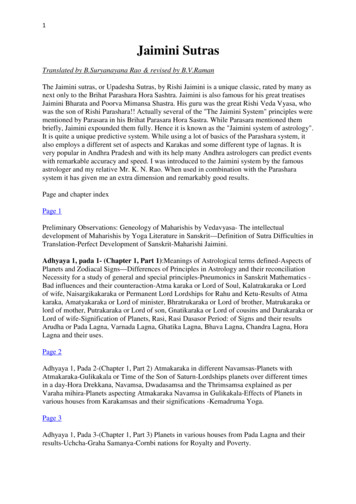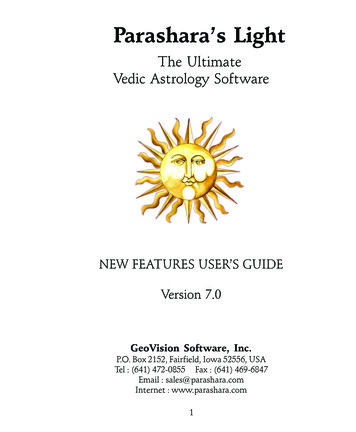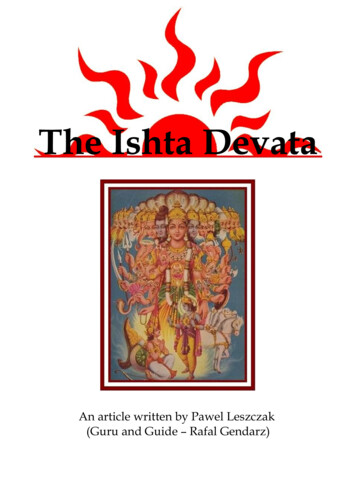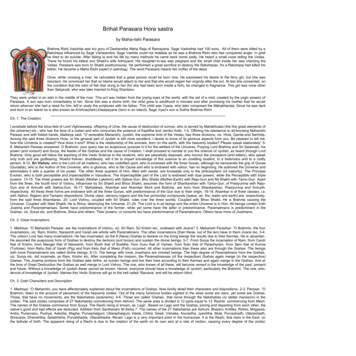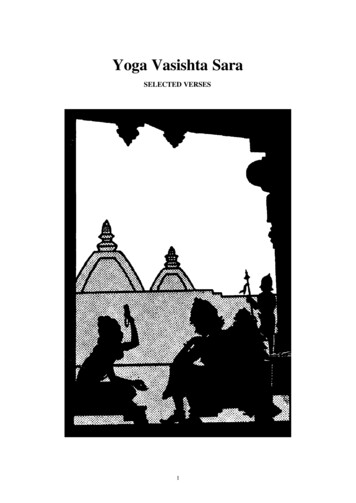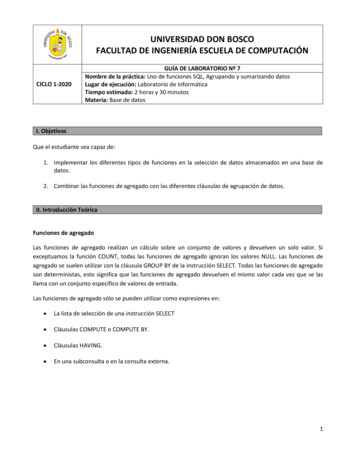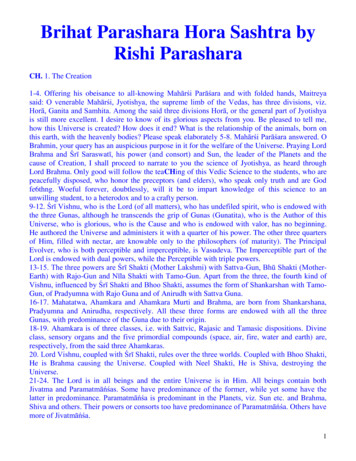
Transcription
Brihat Parashara Hora Sashtra byRishi ParasharaCH. 1. The Creation1-4. Offering his obeisance to all-knowing Mahārśi Parāśara and with folded hands, Maitreyasaid: O venerable Mahārśi, Jyotishya, the supreme limb of the Vedas, has three divisions, viz.Horā, Ganita and Samhita. Among the said three divisions Horā, or the general part of Jyotishyais still more excellent. I desire to know of its glorious aspects from you. Be pleased to tell me,how this Universe is created? How does it end? What is the relationship of the animals, born onthis earth, with the heavenly bodies? Please speak elaborately 5-8. Mahārśi Parāśara answered. OBrahmin, your query has an auspicious purpose in it for the welfare of the Universe. Praying LordBrahma and Śrī Saraswatī, his power (and consort) and Sun, the leader of the Planets and thecause of Creation, I shall proceed to narrate to you the science of Jyotishya, as heard throughLord Brahma. Only good will follow the teaCHing of this Vedic Science to the students, who arepeacefully disposed, who honor the preceptors (and elders), who speak only truth and are Godfe6thng. Woeful forever, doubtlessly, will it be to impart knowledge of this science to anunwilling student, to a heterodox and to a crafty person.9-12. Śrī Vishnu, who is the Lord (of all matters), who has undefiled spirit, who is endowed withthe three Gunas, although he transcends the grip of Gunas (Gunatita), who is the Author of thisUniverse, who is glorious, who is the Cause and who is endowed with valor, has no beginning.He authored the Universe and administers it with a quarter of his power. The other three quartersof Him, filled with nectar, are knowable only to the philosophers (of maturity). The PrincipalEvolver, who is both perceptible and imperceptible, is Vasudeva. The Imperceptible part of theLord is endowed with dual powers, while the Perceptible with triple powers.13-15. The three powers are Śrī Shakti (Mother Lakshmi) with Sattva-Gun, Bhū Shakti (MotherEarth) with Rajo-Gun and Nīla Shakti with Tamo-Gun. Apart from the three, the fourth kind ofVishnu, influenced by Śrī Shakti and Bhoo Shakti, assumes the form of Shankarshan with TamoGun, of Pradyumna with Rajo Guna and of Anirudh with Sattva Guna.16-17. Mahatatwa, Ahamkara and Ahamkara Murti and Brahma, are born from Shankarshana,Pradyumna and Anirudha, respectively. All these three forms are endowed with all the threeGunas, with predominance of the Guna due to their origin.18-19. Ahamkara is of three classes, i.e. with Sattvic, Rajasic and Tamasic dispositions. Divineclass, sensory organs and the five primordial compounds (space, air, fire, water and earth) are,respectively, from the said three Ahamkaras.20. Lord Vishnu, coupled with Śrī Shakti, rules over the three worlds. Coupled with Bhoo Shakti,He is Brahma causing the Universe. Coupled with Neel Shakti, He is Shiva, destroying theUniverse.21-24. The Lord is in all beings and the entire Universe is in Him. All beings contain bothJivatma and Paramatmāńśas. Some have predominance of the former, while yet some have thelatter in predominance. Paramatmāńśa is predominant in the Planets, viz. Sun etc. and Brahma,Shiva and others. Their powers or consorts too have predominance of Paramatmāńśa. Others havemore of Jivatmāńśa.1
CH. 2. Great Incarnations1. Maitreya: O Mahārśi Parāśara, are the incarnations of Vishnu, viz. Śrī Rama, Śrī Krishna etc.,endowed with Jivāńś? 2. Mahārśi Parashara: O Brahmin, the four incarnations, viz. Ram, Krishna,Narasimha and Varaha are wholly with Paramatmāńś. The other incarnations (than these, out ofthe ten) have in them Jivāńś too.3-4. The unborn Lord has many incarnations. He has incarnated, as the 9 (Nava) Planets tobestow on the living beings the results due to their 10ths. He is Janardana. He assumed theauspicious form of Planets to destroy the demons (evil forces) and sustain the divine beings.5-7. From Sun came the incarnation of Rama, from Moon that of Krishna, from Mars that ofNarasimha, from Mercury that of Buddha, from Jupiter that of Vamana, from Venus that ofParashurama, from Saturn that of Kurma (Tortoise), from Rahu that of Varaha (Pig) and fromKetu that of Pisces (Fish) occurred. Incarnations other than these also are through the Planets. Thebeings with more Paramatmāńś are called divine beings.8-13. The beings with more Jivatmāńś are (mortal) beings. The high degree of Paramatmāńś fromthe Planets, viz. Sun etc. did incarnate, as Ram, Krishna etc. After completing the mission, theParamatmāńśas (of the respective) Planets again merge (in the respective) Planets. The Jivatmaportions from the Planets take births, as human beings and live their lives according to their 10thsand again merge in the Planets. And at the time of Great Destruction the Planets as well merge inLord Vishnu. The one, who knows of all these, will become versed in the knowledge of the past,present and future. Without knowledge of Jyotishya these cannot be known. Hence, everyoneshould have knowledge of Jyotishya, particularly the Brahmin. The one, who, devoid ofknowledge of Jyotishya, blames this Vedic Science will go to the hell called Raurava and will bereborn blind.CH. 3. Planet CHaracters and Description1. Maitreya: O Mahārśi, you have affectionately explained about the incarnations of Planets. Nowkindly tell me in detail their CHaracters and dispositions. 2-3. Parāśara: O Brahmin, listen to theaccount of placement of the heavenly bodies. Out of the many luminous bodies sighted in theskies some are stars, yet some are Planets. Those, that have no movements, are the Nakshatras(asterisms).4-6. Those are called Planets, whiCH move through the Nakshatras (or stellar mansions) in thezodiac. The said zodiac comprises of 27 Nakshatras commencing from Ashvini. The same area isdivided in 12 parts equal to 12 Rāśis commencing from Aries. The names of the Planetscommence from Sun. The Rāśi rising is known, as Lagna. Based on Lagna and the Planets,joining and departing from eaCH other, the natives good and bad effects are deducted.Addition from Santhanam till Sloka 7. The names of the 27 Nakshatras are Ashvini, Bharani,Krittika, Rohini, Mrigasira, Ardra, Punarvasu, Pushya, Aslesha, Magha, Purvaphalguni,Uttaraphalguni, Hasta, CHitra, Swati, Vishaka, Anuradha, Jyeshtha, Mula, Purvashadh,Uttarashadh, Shravana, Dhanistha, Satabhisha, Purvabhadra, Uttarabhadra, Revati.Lagna is a very important point in the horoscope. It is the Rāśi that rises in the East, on thelatitude of birth. The apparent rising of a Rāśi is due to the rotation of the earth on its own axis ata rate of motion, causing every degree of the zodiac seemingly ascend on the eastern horizon.Approximately two hours are required for a Rāśi to pass via the horizon, thereby every degreetaking four minutes to ascend. This duration, however, is actually dependent on the concernedlatitude.Actually Sun has no motion. His motion is an apparent one, as viewed from the rotating earth.Other Planets, including the nodes, have v6thed rates of motion. The average daily motions of the2
Planets, whiCH are not, however standard, are, as follows: Sun 1, Moon 13-15, Mars30-45,Mercury 65-100, Venus 62-82, Jupiter 5-15, Saturn 2, Rahu/Ketu 3.With suCH different motions, a Planet forms various Aspects with others. These Aspects throughlongitudinal distances have a great deal of utility in Jyotishya. This is what Mahārśi Parasharasuggests to be considered.7. Details (of astronomical nature) of stars have to be understood by general rules, while I narrateto you about the effects of Planets and Rāśis.8-9. The positions of the Planets for a given time be taken, as per Drikganit. And with the help ofRāśi durations, applicable to the respective places, Lagna at birth should be known. Now, I tellyou about the castes, descriptions and dispositions of the Planets.10. Names of Planets. The names of the nine Planets, respectively, are Sun, Moon, Mars,Mercury, Jupiter, Venus, Saturn, Rahu and Ketu.11. Benefics and Malefics. Among these, Sun, Saturn, Mars, decreasing Moon, Rahu and Ketu(the ascending and the descending nodes of Moon) are malefics, while the rest are benefics.Mercury, however, is a malefic, if he joins a malefic.Addition from Santhanam till Sloka 12-13. When Moon is ahead of Sun, but within 120, she hasmedium strength. Between 120 to 240 she is very auspicious,( see Atishubhapred). From 240 to 0she is bereft of strength. This is Yavana’s view; vide P. 70 of my English Translation of Saravali.This view is, however, related to Moon’s strength, or otherwise, while the waning Moon (KrishnaPaksha, dark half) is a malefic and waxing Moon (Shukla Paksha, bright half) is a benefic. ShouldMoon be conjunct with a benefic, or receiving a Aspect from a benefic, she turns a benefic, evenif in a waning state. As regards Mercury, we have clear instructions from Mahārśi Parashara, thathe becomes a malefic, if he joins a malefic. If waning Moon and Mercury are together, both arebenefics.12-13. Planet governances. Sun is the soul of all. Moon is the mind. Mars is ones strength.Mercury is speeCH-giver, while Jupiter confers Knowledge and happiness. Venus governs semen(potency), while Saturn denotes grief.14-15. Planet cabinet. Of royal status are Sun and Moon, while Mars is the Army CHief. Princeapparent is Mercury. The ministerial Planets are Jupiter and Venus. Saturn is a servant. Rahu andKetu form the Planet Army.16-17. Complexions of Planets. Sun is blood-red. Moon is tawny. Mars, who is not very tall isblood-red, while Mercury’s hue is akin to that of green grass. Tawny, v6thegated and dark areJupiter, Venus and Saturn in their order.18. Deities of Planets. Fire (Agni) (?), Water (Varuna), Subrahmanya (Lord Shiva’s son,following Ganesha), Maha Vishnu, Indra, ShaCHi Devi (the consort of Lord Indra) and Brahma(?) are the presiding deities of the 7 Planets in their order.19. Gender of the Planets. Mercury and Saturn are neuters. Moon and Venus are females, whileSun, Mars and Jupiter are males.20. Primordial compounds. Jupiter, Saturn, Mars, Venus and Mercury, respectively govern thePanCHabhutas, space, air, fire, water and earth.21. Castes of Planets. Jupiter and Venus are Brahmins. Sun is a royal Planet, while Moon andMercury belong to commercial community. Saturn rules the Sudras (4th caste).22. Nature of Planets. Sattvic Planets are the lumin6thes (Sun & Moon) and Jupiter, Venus andMercury are Rajasik, while Mars and Saturn are Tamasic.23. Description of Sun. Sun’s eyes are honey-colored. He has a square body. He is of clean habits,bilious, intelligent and has limited hair (on his head).24. Description of Moon. Moon is very windy and phlegmatic. She is learned and has a roundbody. She has auspicious looks and sweet speeCH, is fickle-minded and very lustful.3
25. Description of Mars. Mars has blood-red eyes, is fickle-minded, liberal, bilious, given toanger and has thin waist and thin physique.26. Description of Mercury. Mercury is endowed with an attractive physique and the capacity touse words with many meanings. He is fond of jokes. He has a mix of all the three humors.27. Description of Jupiter. Jupiter has a big body, tawny hair and tawny eyes, is phlegmatic,intelligent and learned in Shastras.28. Description of Venus. Venus is CHarming, has a splendorous physique, is excellent or greatin disposition, has CHarming eyes, is a poet, is phlegmatic and windy and has curly hair.29. Description of Saturn. Saturn has an emaciated and long physique, has tawny eyes, is windyin temperament, has big teeth, is indolent and lame and has coarse hair.30. Description of Rahu and Ketu. Rahu has smoky appearance with a blue mix physique. Heresides in forests and is horrible. He is windy in temperament and is intelligent. Ketu is akin toRahu.31. Primary ingredients (or Sapta Dhatus). Bones, blood, marrow, skin, fat, semen and musclesare respectively denoted by the Planets: Sun, Moon, Mars, Mercury, Jupiter, Venus and Saturn.32. Abodes of the Planets. Temple, watery place, place of fire, sport-ground, treasure-house, bedroom and filthy ground: these are, respectively, the abodes for the seven Planets from Sunonward.33. Planet periods. Ayan, Muhurta, a day (consisting day and night), Ritu, month, fortnight andyear: these are the periods allotted to the Planets from Sun to Saturn.34. Tastes of the Planets. Pungent, saline, bitter, mixed, sweet, acidulous and astringent are,respectively, tastes lorded by Sun, Moon, Mars, Mercury, Jupiter, Venus and Saturn.35-38. Strengths of Planets. Strong in the East are Mercury and Jupiter. Sun and Mars are so inthe South, while Saturn is the only Planet, that derives strength in the West. Moon and Venus areendowed with vigor, when in the North. Again, strong during night are Moon, Mars and Saturn,while Mercury is strong during day and night. The rest (i.e. Jupiter, Sun and Venus) are strongonly in daytime. During the dark half malefics are strong. Benefics acquire strength in the brighthalf of the month. Malefics and benefics are, respectively, strong in Dakshinayan and Uttarayan.The Lords of the year, month, day and Hora (hour of Planet) are stronger than the other inascending order. Again, stronger than the other in the ascending are Saturn, Mars, Mercury,Jupiter, Venus, Moon and Sun.39-40. Related to trees. Sun rules strong trees (i.e. trees with stout trunks), Saturn useless trees,Moon milky trees (and rubber yielding plants), Mars bitter ones (like lemon plants), Venus floralplants, Jupiter fruitful ones and Mercury fruitless ones.41-44. Other matters. Rahu rules the outcaste, while Ketu governs mixed caste. Saturn and thenodes indicate ant-hills. Rahu denotes multi-coloured clothes and Ketu rags. Lead and blue gembelong to Rahu and Ketu. Sun, Moon, Mars, Mercury, Jupiter, Venus and Saturn in their ordergovern red silken, white silken, red, black silken, saffron, silken and multi-coloured robes.45-46. Seasons of Planets. Vasanta, Greeshma, Varsh, Sarad, Hemanta and Si
Brihat Parashara Hora Sashtra by Rishi Parashara CH. 1. The Creation 1-4. Offering his obeisance to all-knowing Mahārśi Parāśara and with folded hands, Maitreya said: O venerable Mahārśi, Jyotishya, the supreme limb of the Vedas, has three divisions, viz. Horā, Ganita and Samhita. Among the said three divisions Horā, or the general part of JyotishyaFile Size: 1005KBPage Count: 169Explore furtherBrihat Parasara Hora sastra - Shenjivashenjiva.comBrihat Parashara Hora Shastra : Free Download, Borrow, and .archive.orgBrihat Parashara Hora Shastra - Vedic Astrology Article .www.vedic-astrology.netParashara Hora Sastra : Parashara : Free Download, Borrow .archive.orgDownload Books - Jyotish Vidyajyotishvidya.comRecommended to you based on what's popular Feedback
